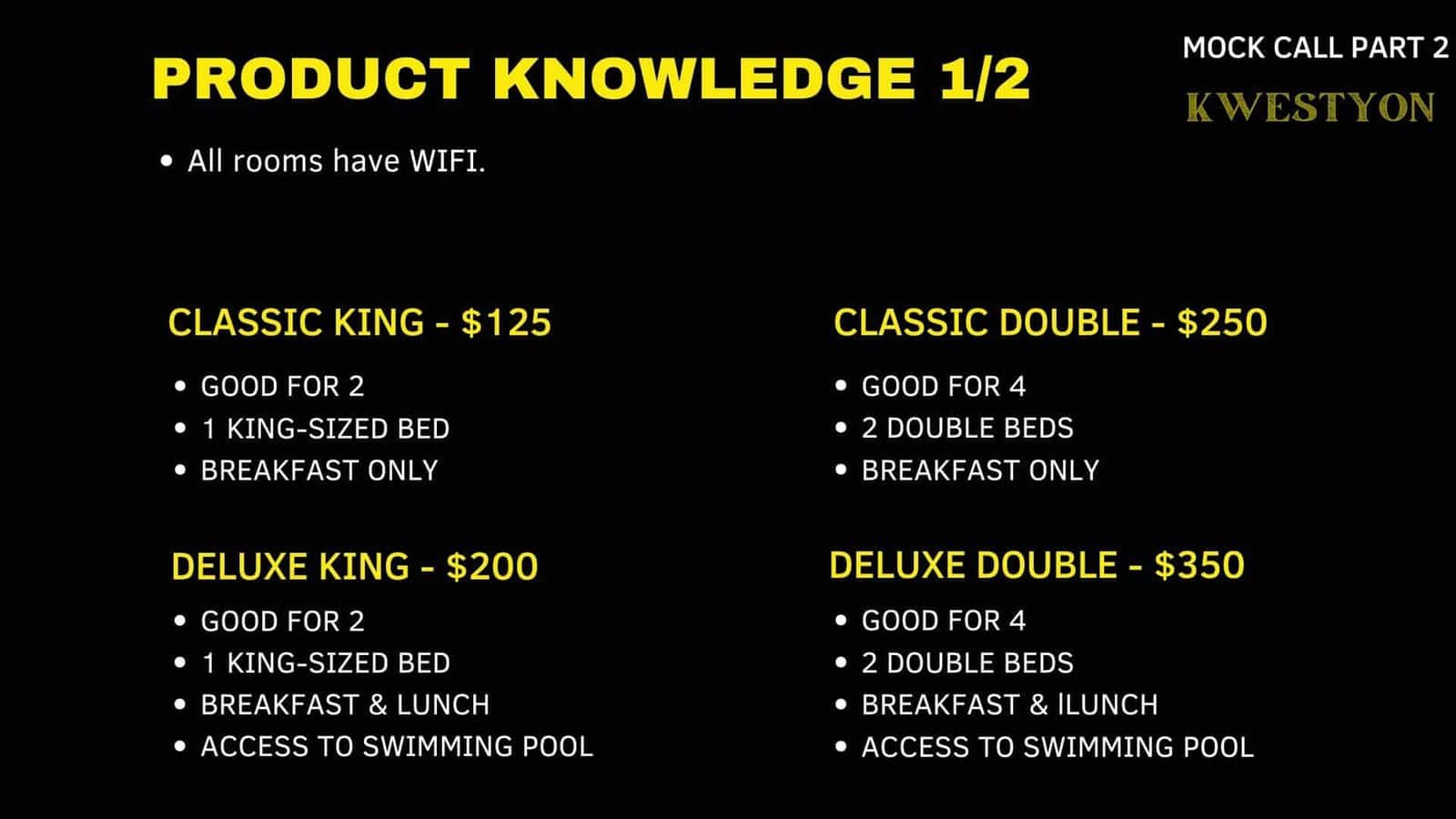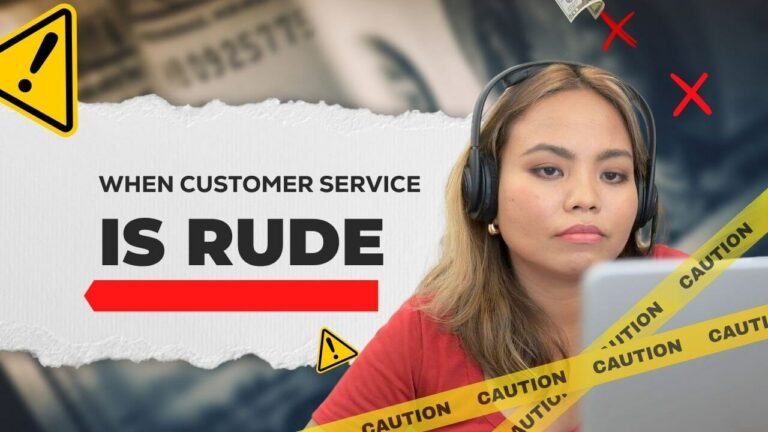When applying in a voice account, you can avoid Berlitz. You can avoid Versant. Heck, you can even avoid a typing speed test. Unfortunately, you can’t avoid mock calls.
Therefore, it’s very important that before you apply, you should already know what to say and do during a mock call test. Here’s a detailed guide on how to pass a mock call test, whether you’re a call center newbie or a veteran.
Table of Contents
What happens during a mock call?
- First, the facilitator will give you a piece of paper. On that paper is the Product Knowledge. It contains the info of the product that you’re gonna be representing during the call.
Here is the Product Knowledge of the second mock call video in this article.


- Next, the facilitator will give you around 10-15 minutes to read and absorb what’s on the Product Knowledge.
- No worries, during the mock call, you will still have access to the Product Knowledge. Still the more you absorb and familiarize the Product Knowledge, the better your chances of cracking your mock call test.
- Lastly, the facilitator/ interviewer will instruct you to answer the call via a telephone or a headset once it rings. And then the mock call begins. You will act as the call center agent, and the facilitator/your interviewer will act as the customer.
Passing a mock call is actually simple.
I know that a lot of you (especially call center newbies) are terrified at the thought of undergoing a mock call to the point of avoiding call center companies that impose a mock call during the initial application process.
But you see, mock calls are actually simple.
Here’s why: To pass a mock call test, all you have to do is follow the call flow. If you can follow the call flow (which is super easy with enough practice), then you’ll pass your mock call!
What the heck is a call flow?
Well, simply put, a call flow is the sequence of a call. It outlines what comes first, second, third, fourth, and so on… Normally, it has 5 parts: opening, probing, research, solution, and closing.
But I want you to ignore that. I have an easier and better format!
Instead, I want you to think of the call flow as a series of verbs instead.
This way, they are more alive and clearer to you. They are instructional. If you’re in the middle of the call and you feel lost, you can refer back to these steps and you’ll know exactly what to do.
Here are my recommended 7 steps when handling a call:
- Open the call (always)
- Empathize, apologize or assure (whichever applies).
- Confirm the customer’s account (if applicable).
- Probe/ ask relevant question/s (if applicable). Repeat as necessary.
- Solve the problem or answer the question (always).
- Offer additional assistance (always).
- Close the call (always).
I created the video below with a sample mock call to show you what each of the steps means.
If you want a written format for each step, I’ve included them after the transcript of this video.
Mock Call Script Sample/ Call Simulation Sample
STEP 1:
Agent: Hi. Thank you for calling PowerUp Company. This is Candace. How may I help you?
Caller: Hi Candace. So… I’m calling because you guys overcharged me. My subscription to you guys is supposed to be a flat-rate fee of $30.00 per month. But for some reason, I am seeing a $33.00 on my paper bill for the month of July. So… I don’t know what’s going on. I would really appreciate an explanation on this.
STEP 2 & 3:
Agent: Sure, I’ll be happy to pull up your account now and check the billing details for you. Can I have your account number together with your first and last name?
Caller: Sure, it’s 12345. And my full name is Joan Williams.
STEP 4:
Agent: Thank you, Joan. Just give me a few seconds to pull up your account. It was for the month of July this year, right? July 2020?
Caller: That’s right!
STEP 5:
Agent: Okay, let me see that… Okay, I have your account pulled up now and I’m only seeing a $30.00 charge for the month of July this year. Could you recheck your bill and review the amount? (STEP 4 repeated)
Caller: No, that can’t be right. I am literally holding my bill right now, and it says July, and it says $33.00 in big, bold letters. So maybe the charge was moved to June or August? I don’t know. All I know is that you’re overcharging me. And it’s written on my paper bill.
STEP 5:
Agent: Yes, Joan. I also checked your other months’ charges this year from January to July 2020 And for all of these months, you were only charged $30.00 each. Let me just check further though… your last year… Oh, although I am seeing a $33.00 charge here but this was way back last year in July 2019. Would you mind checking the year of the billing paper you’re holding right now?
Customer: Oh! Oh my god. Candace, I am so sorry to have wasted your time. I really thought this was a recent bill!
Agent: No, don’t worry about it, Joan. You’re fine.
Customer: This bill was literally on my table this morning. I must have dropped it when I was throwing garbage this morning. So embarrassing. My bad.
Agent: Oh, no problem. It happens… I mean it happens to all of us, you know.
Customer: I know right! Anyway, Candace. I won’t waste any more of your time and thank you so much for your patience.
STEP 6:
Agent: You’re welcome, Joan. Is there anything else that I can help you with today, maybe?
Customer: No, that’s all Candace. I won’t waste any more of your time. Have a good one!
STEP 7:
Agent: Have a good one, Joan. Thank you for calling PowerUp. Bye!
Customer: Bye, Candace.
The 7 Steps of Call Flow
Step 1: Open the call (always).
To open the call, greet and thank the customer for calling, mention the company name, your name, and the question, “How may I help you?”
“Hi, thank you for calling PowerUp Company. This is Candace. How may I help you?”
Step 2: Empathize, apologize or assure (whichever applies).
A. Empathize to let the customer know that you feel her situation but it’s NOT your company’s fault.
“I’m so sorry to hear that. That must be really hard for you.”
B. Apologize if it’s your company’s fault.
“We apologize for the delay, Sara. I’ll certainly do my best to help you get your order delivered to you as soon as possible.”
C. Assure if the customer just wants her question answered and isn’t really experiencing any inconvenience nor expressing any frustration.
“Sure, I’ll be happy to check the account for you!”
Step 3: Confirm the customer’s account (if applicable).
“For security purposes, may I know your account number together with your full name?”
- No need to confirm the customer’s account if the customer doesn’t have an account with the company.
- No need to confirm the account if the customer’s concern is not account-related or if it can be answered without opening her account.
- For example, a customer asks, “Do you have a physical store?”, then you can just answer this ASAP without asking her to confirm her account. It’s not account-related.
Step 4: Probe/ ask relevant question/s (if applicable). Repeat as necessary.
There are times when a customer’s explanation isn’t enough for you to fully understand her question or issue.
If this is the case, you need to ask the customer a question (or a series of questions) to clarify the situation and/ or get more information.
Please refer to the full video above to see an example of a probing question.
Of course, if the question is pretty simple and you understand it 100%, then you can skip this part and proceed to step 5.
Step 5: Solve the problem or answer the question (always).
Once you have fully understood the customer’s concern or question, then it’s now time to either solve the customer’s problem or answer her question.
- If you need more time to search for the answer or solve the problem, then you can put the customer on hold. The maximum recommended time for calls is 2 minutes.
- To put the customer on hold, you can say, “Can I put you on hold for a minute or two to check with my supervisor (or to check your account)?”
- If the solution that the customer wants isn’t possible, then you can provide an alternative resolution that is closest to what she wants while also following your company’s policy.
- I’ll be creating a mock call scenario about this in the future so make sure to subscribe to my YouTube channel.
Step 6: Offer additional assistance (always).
This step is made up of only one sentence but it’s super essential in customer service.
“Is there anything else that I can help you with today?”
Most of the time, customers would say no to this so you can just proceed to step 7. But there are times when merely asking this question reminds customers of their other concerns.
Therefore, you must ask this question to avoid the customer from unnecessarily making two calls when her concerns could have addressed in one call.
Step 7: Close the call (always).
If the customer confirms that she has no more questions nor concerns, then it is time to close the call.
For this, thank the customer for calling, mention your company name, then a greeting.
“Thank you for calling PowerUp Company. Have a great day! Bye.”
Booking Mock Call Recording (With Explanations)
If you need more mock call practice, watch this.
In this booking mock call video, I explained in great detail the 7 steps of the call flow. This will help you understand why I said the things I said during the call.
This will train you to think like a real call center agent. Remember, to have a better chance at passing a mock call, you need to train yourself to think like a real call center agent as soon as possible.
STEP 1:
Candace: Hi, thank you for calling Hotel California. This is Candace. How may I help you?
Stephen: Hi, this is Stephen. I’d like to book for four people, please. And that would be for August 18th.
STEP 2 & 4:
Candace: Sure Stephen, I’d be happy to help you with that. So which room do you have in mind?
Stephen: Actually, I gotta tell you first. I’m super busy so haven’t been able to browse through your website so I don’t really know the rooms you have right now. But I could give you my requirements then you suggest the best rooms for me. Could we do that?
STEP 4:
Candace: Absolutely! What do you need?
Stephen: So there are 4 of us… including me. And we need something with a WiFi and maybe a swimming pool.
STEP 4:
Candace: Got it. Will you four be staying in one room or separate rooms?
Stephen: Oh, sorry I forgot to tell you. That would be separate, cause you see, we’re two couples and we would need two rooms.
STEP 5:
Candace: I see. So in that case, I recommend two DELUXE KINGs. It has a king-sized bed that fits two people, a WIFI, an access to a swimming pool, and free lunch and breakfast. All these for $200 each, which is $400 for 2 rooms. How does that sound?
Stephen: Oooh…. That’s a bit too much. That’s a bit expensive. Actually, do you maybe have something more affordable than that? Now that I think about it, I remember there’s a beach close to your hotel so we’ll probably just take a trip there so you can take out the swimming pool. Is that possible?
STEP 5:
Candace: Sure. Let me see. So, if you want to take out the swimming pool and just have the WIFI, then we certainly have a room for that which is the CLASSIC KING for $125 each, which is only $250 for two rooms as opposed to $400. You’re still gonna get the king-sized bed and the WIFI. But I have to tell you, Stephen, aside from having no swimming pool, you will also only get a free breakfast instead of lunch and breakfast. Is that okay with you?
Stephen: Perfect, perfect Candace. That’s exactly what we need. We’ll be having lunch at the beach anyway so we won’t be eating at the hotel. So 2 CLASSIC KING it is! So do you need my credit card number?
Stephen: Okay cool. You can send it to [email protected].
Candace: How do you spell Stephen? Is that Steven with a V or a Stephen with a P?
Stephen: With a P.
Candace: Thank you… So just to make sure, that is S for Sierra, T for tango, E for echo, P for Peter, H for hotel, E for echo, N for Nancy, underscore [email protected]. Is that correct?
Stephen: Yep, that’s correct.
Candace: Perfect! So just to recap you will be booking two CLASSIC KING rooms this August 18th, 2020. And the total amount is $250.00. Are all of these correct?
Candace: Thank you. So after this call, Stephen, you should receive an email from [email protected]. In that email, is a secure link that you can click where you can enter your full name and card info. I also wanna remind you not to click any email that is NOT from [email protected]. We only take payments through this one email. Alright?
Stephen: Gotcha.
STEP 6:
Candace: Is there anything else that I can help you with today?
Stephen: Nope. You’ve been very helpful Candace. Thank you so much!
STEP 7:
Candace: You are most welcome Stephen! Thank you for calling Hotel California. Have a great day!
Stephen: Have a great day Candace. Bye!
How to pass a mock call test: tips and tricks
If you prefer to watch a video than read, then here’s the video version of the mock call tips and tricks. Otherwise, read on.
1. Learn the call flow by heart.
Whether it’s an actual call or a call simulation, the call flow is the only criterion when grading the quality of a call. If you don’t know the call flow by heart, then you might as well stop hoping of passing your mock call.
While call flow comes naturally to an experienced call center agent, you, as a newbie should learn and understand it by heart through constant practice. Again, I have a lot of mock call videos on my YouTube channel so make sure to check those.
2. Pay very close attention to the Product Knowledge.
You probably notice that I always include a Product Knowledge in all of my mock call videos. And for good reason: I want to make your mock call practice videos as realistic as possible.
Again, before a mock call test, the facilitator will give you around 10-15 minutes to read, familiarize, and understand the Product Knowledge. That’s how important it is.
Also, understanding the Product Knowledge will give you a clue as to the possible questions that the customer might ask during the call.
3. When confused, put the customer on hold.
Steps 1, 2, 3, and 4 are easy and straightforward enough.
However, once you get to step 5 (which is to solve the problem or answer the question), it could be a bit tricky. It is perfectly normal to feel confused and lost during this step, especially for a newbie.
If this happens, relax. Put the customer on hold for a maximum of 2 minutes.
This is useful if you need more time to research or figure out the solution to the customer’s problem or answer to her question.
To put the customer on hold, state the reason for the hold and for how long. Two minutes is usually the maximum. You can say something like,
“For me to check your account, can I put you on hold for a minute or two?”
“Can I put you on hold for 2 minutes? I would have to check this with the Refunds department.“
4. Practice positive scripting.
Think of positive scripting as making a bad news sound less bad as possible. It also makes everything sound polite and professional. Here are some examples:
POSITIVE SCRIPTING EXAMPLE 1:
No positive scripting: Are you sure this is your account number?
With positive scripting: I couldn’t seem to find a match of this number. Do you mind rechecking the number on your screen?
Now, notice that the statement without positive scripting is more accusatory. It sounds like the agent is accusing the customer of her mistake.
But remember, even if it’s the customer’s mistake, you don’t wanna make it sound like it is!
On the other hand, the statement with positive scripting is more polite. It doesn’t point out the customer’s mistake and yet it accomplishes the goal just the same (to tell the customer that she gave the wrong number).
POSITIVE SCRIPTING EXAMPLE 2:
No positive scripting: No, we don’t deliver to addresses outside the US.
With positive scripting: Currently, we don’t deliver to addresses outside the US but if you know someone in the US who could receive the package for you, then have it delivered to your address, then you could still do it that way. A little bit more hassle but not entirely impossible.
Notice that the statement without the positive scripting just flat out said no, that nothing could be done.
However, the statement with positive scripting came up with an alternative option for the customer.
This makes a customer feel that her problem matters to you and that you’re trying hard to get her the best resolution possible even if the company’s process couldn’t make it possible.
In my next mock call videos, I’m gonna be focusing on positive scripting so subscribe to my YouTube channel. A mock call test might sound hard to you but with enough practice, it really isn’t! Lots of applicants can and will pass it. So will you. 😉
Alright, that is all for today. If you have any questions and requests for my next videos, comment down below and I’ll make them next. Good luck!




